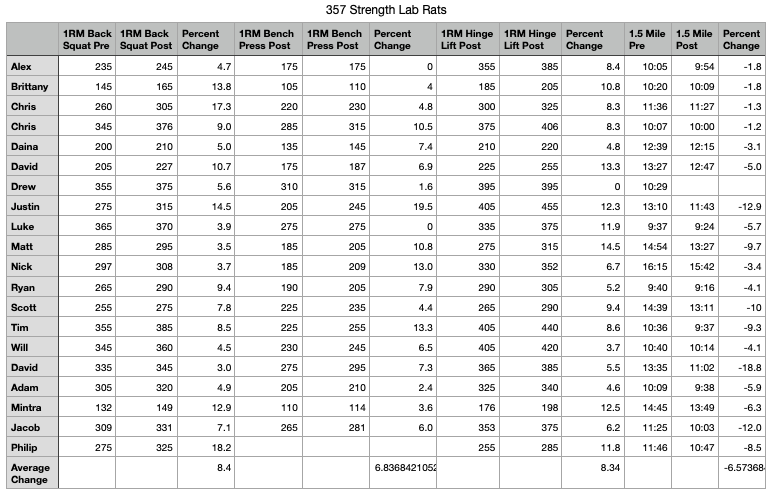By Rob Shaul, Founder
BLUF
MTI’s 357 Strength progression methodology matched MTI’s Density Strength progression in strength gains, and in a cycle that paired strength training with endurance, outperformed in endurance performance.
Background and Study Design
We conducted a 3.5-week Mini-Study using remote lab rats to test the effectiveness of MTI’s 357 Strength progression to MTI’s Density Progression.
One group of remote Lab Rats completed the study in January, 2021 and their results were compared to a similar study on Density Strength conducted previously.
357 Strength combines the proven strength training methodology we’ve developed at MTI, with the hormonal “flush” theory experienced by CrossFitters. Heavy strength is followed by complementary, short, intense, work capacity efforts designed to follow up the max effort, central nervous system-focused strength training with a complementary hormonal flush.
The key to 357 Strength is the complementary work capacity effort. Varying in duration from 3 minutes, 5 minutes, to 7 minutes, these work caps utilize the same exercises conducted in the strength portion to create a “hormonal flush.” This shocks the body to overcompensate during recovery, resulting in greater gains than if the exercises were completed in the same volume, but with less intensity.
357 Strength is one of our most successful strength training programs, and also one of our most fun. However, we’ve never formally tested our 357 Strength theory until now.
This study piggybacked on another mini-study we completed in the Fall of 2019 which compared MTI’s Density Strength and Super Squat Strength methodologies. That study found that Density Strength leads to greater strength gains.
This study deployed the same Density Strength programming as the 2019 study, with one change. The Monday, Wednesday and Friday strength work was be followed by a 3-7 minute short, intense work capacity effort deploying the same muscles and movement patterns and designed to create the hormonal “flush” – turning this programming into 357 Strength.
All lab rats will completed the same, 5-day/week programming. Strength programming was built around a 1 Repetition Maximum Back Squat, Bench Press, and Hinge Lift. In addition to strength work, the lab rats complete a 1.5 mile run assessment and follow-on 800m interval repeats. Below was the weekly schedule:
- Monday: 357 Strength
- Tuesday: 1.5 Mile Run Assessment or 800m Interval Repeats
- Wednesday: 357 Strength
- Thursday: 800m Interval Repeats
- Friday: 357 Strength
Results and Discussion
A total of 19 individuals completed the entire training 3.5 week cycle. Below are the individual lab rat results.
Below is a comparison to the 357 Strength improvements and the Density Strength improvements from the 2019 Mini Study:
The minor differences in Strength improvements for the individual exercises between Density and 357 Strength are not significant enough to discern a winner.
The significantly greater improvement in the 357 Strength lab rats’, 1.5 run assessment is surprising. The only difference between the two cycles was the 3-7 minute, primarily bodyweight, work capacity effort each Monday, Wednesday and Friday in the 357 Strength study.
The “hormonal flush” theory did not pan out in the strength improvement results. However, it seems this minor addition of short, threshold work capacity did not hurt strength gains and seemed to “juice” the endurance performance of the training plan.
From a programming perspective, especially in terms of improving multiple fitness attributes across a single training cycle, knowing that short work capacity transfers to endurance as demonstrated in this study, is significant.
Next Steps?
The study results do not show that short, complementary, work capacity efforts following strength training increased strength gains. However, the results hint that short, work capacity efforts can lead to significantly increased gains in endurance when combined with regular, MTI mode-specific endurance programming.
This could lead to programming changes at MTI.
Two plans, in particular, Big 3 + 5-Mile Training Plan and the Big 3 + 2-Mile Training Plan are ripe for the addition of short work capacity efforts following strength to improve/enhance the endurance increase/training in the plan.
As well, a potential study in the future would be to include short, work capacity efforts in endurance-focused plans. It’s possible these short efforts would minimally impact recovery and fatigue, yet could improve endurance improvement.
Look for a mini-study analyzing this idea in the future.
Questions? Email rob@mtntactical.com
Comments? Please comment below.
You Might Also Like MTI’s 357 Strength Training Plan



